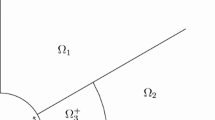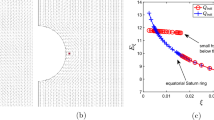Abstract:
We study the director field around a spherical particle immersed in a uniformly aligned nematic liquid crystal and assume that the molecules prefer a homeotropic orientation at the surface of the particle. Three structures are possible: a dipole, a Saturn-ring, and a surface-ring configuration, which we investigate by numerically minimizing the Frank free energy supplemented by a magnetic-field and a surface term. In the dipole configuration, which is the absolutely stable structure for micron-size particles and sufficiently strong surface anchoring, a twist transition is found and analyzed. We show that a transition from the dipole to the Saturn ring configuration is induced by either decreasing the particle size or by applying a magnetic field. The effect of metastability and the occurrence of hysteresis in connection with a magnetic field are discussed. The surface-ring configuration appears when the surface-anchoring strength W is reduced. It is also favored by a large saddle-splay constant K24. A comparison with recent experiments [#!itapdb:Poulin1997!#,#!itapdb:Poulin1998!#] gives a lower bound for W, i.e., W >0.06erg/cm2for the interface of water and pentylcyanobiphenyl (5CB) in the presence of the surfactant sodium dodecyl sulfate.
Similar content being viewed by others
Author information
Authors and Affiliations
Additional information
Received 2 November 1998
Rights and permissions
About this article
Cite this article
Stark, H. Director field configurations around a spherical particle in a nematic liquid crystal. Eur. Phys. J. B 10, 311–321 (1999). https://doi.org/10.1007/s100510050860
Issue Date:
DOI: https://doi.org/10.1007/s100510050860




